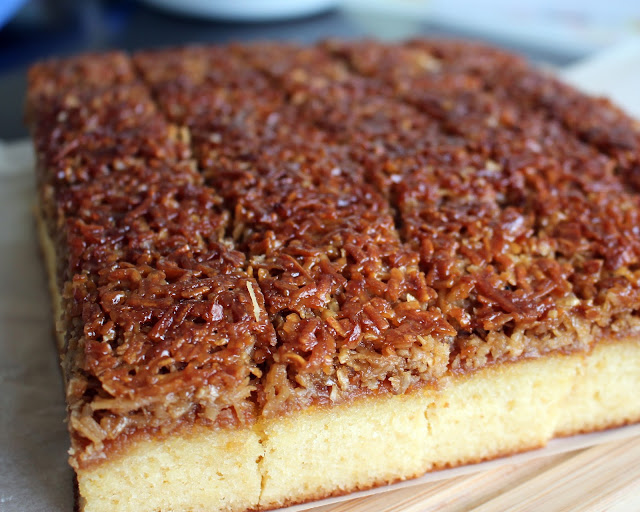I made this cake for the first time as part of the Australia's Biggest Morning Tea fund-raising event at work. It's rather stressful cooking or baking for other people whom you know are going to judge you and your food. I tried to think of what cake would appeal to most people, and the magic ingredient is *drumroll*.... coconut! Australians love coconut (the shredded type) which is probably why lamingtons are so...Aussie.. though not as Aussie as Tim Tams and Vegemite. Coconut is also widely used in Asian cuisine. In fact, some of the people at work commented that it was a Filipino cake, and I said no. This was a Danish Dream Cake. Totally different continents. (I think they might have confused it with Biko, a Filipino dessert made with sticky rice and coconut, though sounds delicious too).
The word "Drømmekage" literally means "dream cake", and is apparently a traditional Danish cake consisting of a genoise sponge with a coconut caramel topping that is baked until caramelized and golden brown. I think my favourite colour has to be caramel. Not just any caramel, but dark and deliciously brown caramel. The cake was lovely and not as sweet as I thought it would be. It must be the salt in the caramel that tones down the sweetness, and on top of that, I also added coffee to it. Coffee and caramel makes for amazing smells in your kitchen! You have to let the cake cool down for an hour before cutting it, but just an hour and no more than that. As a reward, you will get to savour the sweet, juicy crusty edges of the cake which is still slightly warm from the caramel that has melted over the sides and covered it with sticky chewy goodness. This is a cake that would be perfect for a crowd, best eaten in small portions (over and over). Please find the recipe below.
Drømmekage – Danish Coconut Dream Cake
(from ‘Scandilicious – Secrets of Scandinavian Cooking’ by Signe Johansen, Saltyard Books)
Adapted from Usingmainlyspoons
300g golden caster sugar (I used 250g)
1 teaspoon vanilla extract
150g butter, melted
150ml buttermilk (or just plain milk)
300g plain flour
3 teaspoons baking powder
1/4 teaspoon salt
Topping
200g butter (I used 150g)
200g light brown soft sugar
150g dessicated coconut
100ml milk
1 heaped teaspoon vanilla sea salt (I used half teaspoon salt with 1 teaspoon vanilla extract)
1/2 tbsp instant coffee granules/powder (optional - I added this)
Method
Preheat the oven to 190C/170C fan/gas mark 5. Line a 20x30cm deep rectangular cake pan (I used a 23x23cm pan) with parchment paper, leaving a 2 inch overhang to help remove the cake later. It helps to have the paper extend above the sides of the tin a little to contain the topping later.
Melt the butter and leave to cool a little. Combine the flour, baking powder and salt in a bowl, and mix with a whisk to distribute the baking powder.
Using an electric mixer beat the eggs, sugar and vanilla together until thick and pale, the batter should form a ribbon when the whisk is removed from the bowl. This will take several minutes on high speed.
Pour in half the melted butter and buttermilk and sift half the flour onto the batter. Fold the batter together with a large metal spoon, trying to incorporate as much of the flour, butter and buttermilk without knocking out the air from the eggs.
Pour in the remaining butter and buttermilk and sift over the remaining flour. Fold the batter as above.
Pour the batter into the prepared cake pan and bake for 20-25 minutes or until the cake has doubled in size, looks light golden brown in colour and is firm to the touch. A toothpick inserted into the cake should also come out clean. You want to be sure it has baked thoroughly and will bear the weight of the topping to come.
Whilst the cake is baking make the topping by adding all the ingredients into a medium saucepan set over medium heat, stirring constantly to prevent the sugar from burning. Cook for 5 minutes until the mixture has thickened and some of the liquid has evaporated. It will reduce a little and also change colour to a slightly darker shade of brown. You want something thick enough that it will spread over the surface, and not run too much or it may seep into the cake.
Once the cake is out of the oven turn the temperature up to 220C/200C fan/gas mark 7. Spread the topping evenly over the cake, return to the oven and bake on the upper-middle shelf for 5–10 minutes until the topping is a toasted deep golden colour. Cool in the tin before cutting into squares with a serrated knife (I used a bread knife). The top of the topping should be caramelized and chewy, while the coconut beneath is juicy, sweet and addictive! Enjoy!




